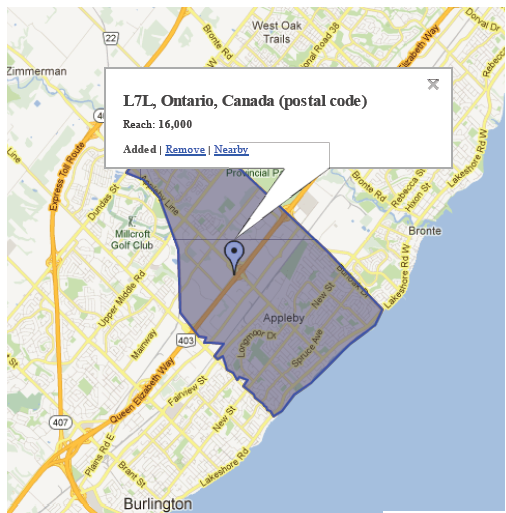Google AdWords Introduces Canadian Postal Code Targeting
Yesterday, Google introduced postal code geo-targeting for Canadian AdWords advertisers. Canadian advertisers can now target over 1,500 Canadian Postal Code FSAs (the first 3 digits of the postal code). We’ve long heard the idea of hyper-local geo-targeting, and finally, it’s truly coming to fruition.
So what does this mean for Canadian SMBs? For the vast majority of businesses, there’s no need to make any changes to your AdWords account. Most businesses are happy with their current geo-targeting, so defining your targeting by postal code instead of by city or radius targeting really doesn’t make a difference.
But there are, as I see it, 2 key takeaways from Google’s move. First, there is one type of business for which this new method of targeting could have a significant impact – franchisees. Secondly, what this move forces all businesses to think about is the connection between online & offline media.
Canadian Postal Code Targeting for Franchises
This could potentially have a significant impact for Canadian franchises, many of which have territories that are defined by postal codes, rather than city limits. In our experience, we’ve seen many franchisees who control their own local advertising budgets, have ended up advertising for neighbouring franchisees.
Let’s take an example of a franchise that takes a city like Toronto and divides it up into 4 separate geographic areas. For the local franchisee in Etobicoke, setting his/her geo-targeting as ‘ Toronto’ would be too broad and result in them advertising for their fellow Toronto-based franchisees. On the other hand, setting their geo-targeting as Etobicoke still results in a ‘ limited reach’ warning from AdWords, which will result in your ads receiving little exposure – only to users who specify the name of the city in their search, or users with GPS-enabled mobile devices where their exact location can be identified.
Now with postal code targeting, franchisees no longer have to worry about this dilemma. Google has a quality threshold in place, so they will only offer postal codes for targeting where they are confident enough to correctly locate the user’s IP address. If they are not confident in assigning IP addresses for a given postal code, they will show a ‘limited targeting’ badge next to the location.
Connecting Your Online & Offline Advertising
Direct mail advertising is generally targeted by postal code, so this new feature from AdWords allows for all kinds of interesting options in terms taking your offline direct mail campaigns, and reflecting that same message online. What has also been introduced is reporting within AdWords that shows KPIs like clicks, impressions & conversion by postal code.
Here are handful of ways that you can integrate your online & offline advertising. Many of these strategies were available prior to this latest change, but it provides me a great excuse to talk about them now.
Online Testing Prior to Advertising Offline
Many SEOs often use PPC advertising as a means of testing for things like determining the real search volume for their target terms and testing out various ad copy that may be useful as a meta description tag, but I don’t think enough people use AdWords as a means of testing strategies for their offline advertising. I’ve long advocated to clients that by examining the CTRs (clickthrough rates) of your AdWords ads, you can see which ads users are responding to. If an ad with a certain tag line or verbiage is being received well online, logic dictates that users would respond to it well offline as well. So if you’re getting ready to send out a direct mail campaign, try using AdWords first to test out different ad copy. There are a lot of different ways of conveying the exact same message. Try out a few different ads that largely say the same thing, but do so with different verbiage, and check to see if one ad receives a statistically significant higher CTR than the other.
Integrating Your Online & Offline Campaigns
We all know that repetition in marketing matters. Any day of the week, I would rather see my clients get exposure to 10,000 consumers 5 times each, rather than 50,000 consumers just once. When you put all of your eggs into one basket and send out that flyer through Canada Post or your local newspaper, and support it up with some other type of marketing, you’re not getting the maximum possible return on your direct mail campaign. You would receive a substantially greater return on your direct mail investment if you set up a Google AdWords campaign that targeted the same postal codes, and contained ads with the same kind of messaging used in your print campaign. You’d want to run the AdWords campaign both before and after the delivery of the direct mail. This increases the chances that consumers will be exposed to your message multiple times within a relatively short period of time. If you were using a dedicated PPC landing page, you could even go to the extent of showing the actual flyer/direct mail piece right on the landing page.
A Note of Caution
One of our favourite phrases (I’m pretty sure I coined it) is ‘data-driven decision making’ – that is, you should make decisions about your business and your marketing based on real data, not just on a whim or based on a gut feeling. How someone interprets the data before them is another story. My worry now is that SMBs will take a look at the postal code data in their AdWords account and make decisions based on statistically insignificant sample sizes. For an average SMB, you shouldn’t be making decisions or conclusions based on AdWords data if you’re looking at less than 10,000 impressions and/or 10 conversions (if you’re tracking conversions). Running a campaign for 1 week and seeing 2 conversions come from 1 postal code, 1 conversion come from a second postal code, and none come from another 3 postal codes does not mean that the latter 3 postal codes are all useless to you and that you shouldn’t focus any efforts on those areas.





